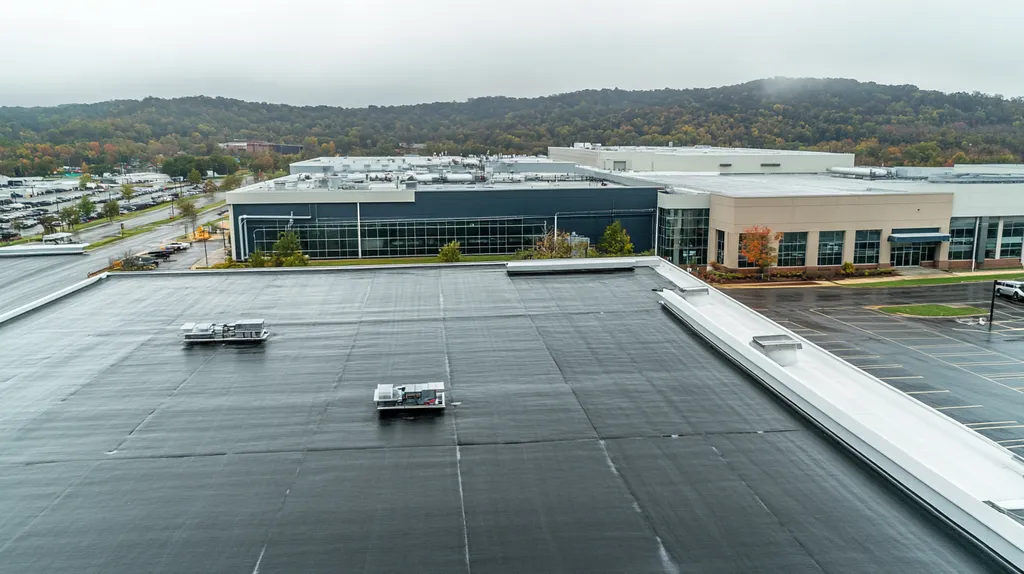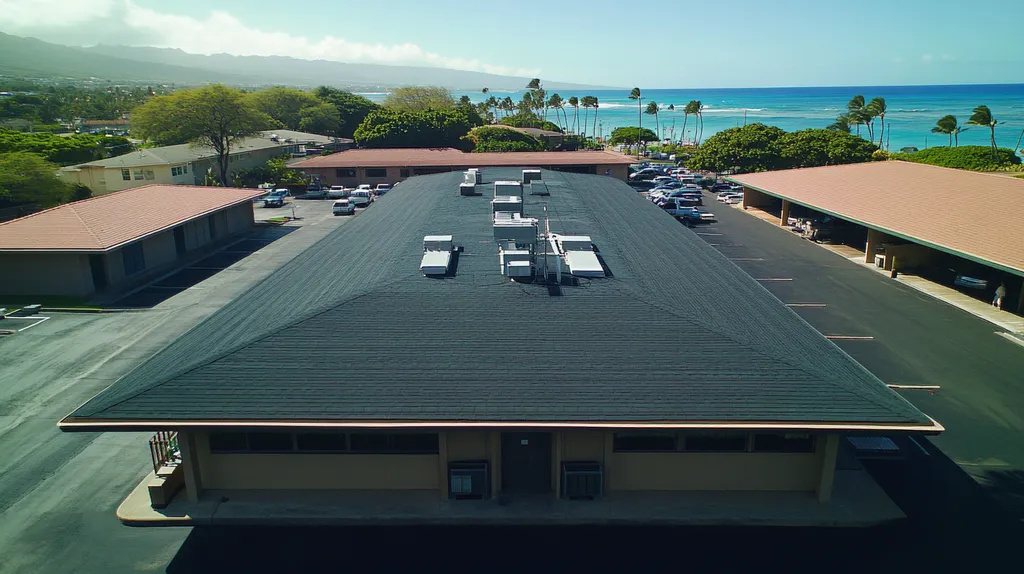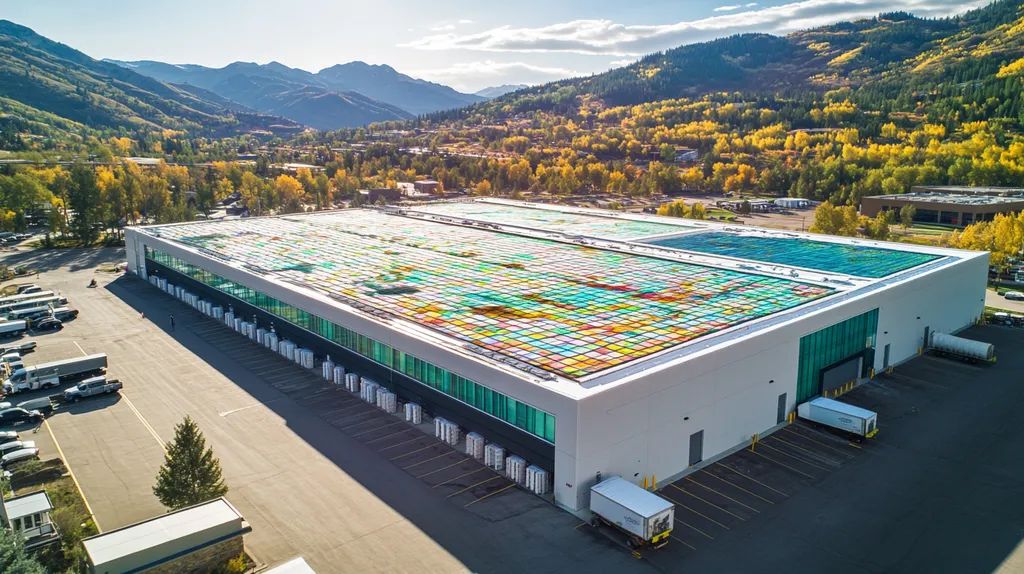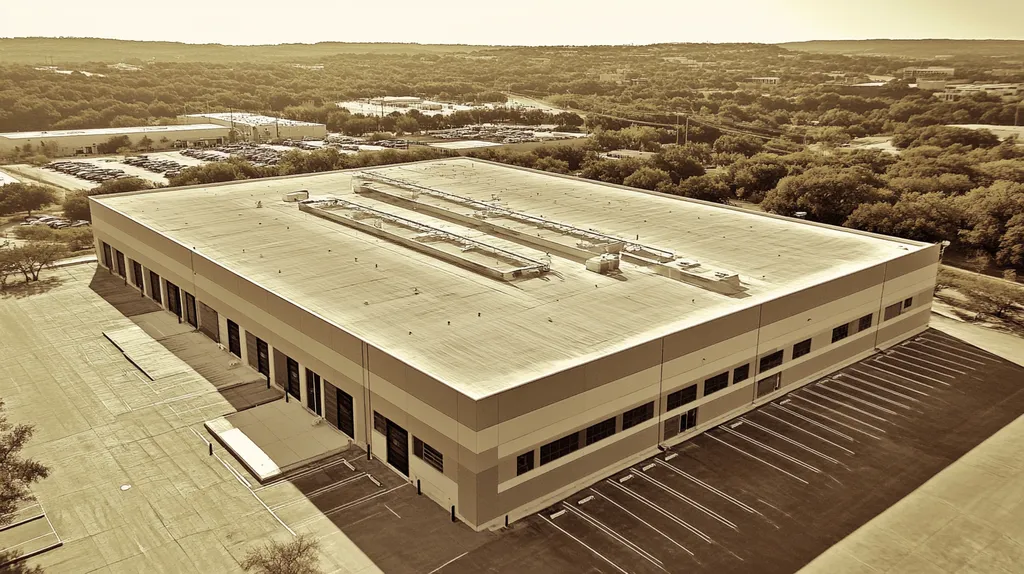As energy costs continue to surge, commercial property owners face mounting pressure to optimize roof performance. Studies show that uncoated roofs can absorb up to 95% of solar radiation, driving cooling costs significantly higher.
Reflective roof coatings represent a proven solution, with the potential to reduce heat absorption by 30-85% while extending roof lifespans by up to 50%.
This comprehensive guide examines the science behind reflective coatings, implementation strategies, and optimization techniques that enable facility managers to transform their highest square footage into an energy-efficient asset.
SECTION 1: FUNDAMENTAL CONCEPTS
The performance of a commercial roof is crucial not only for operational efficiency but also for meeting sustainability targets. As energy costs continue to escalate, property owners are increasingly burdened by rising energy bills driven by heat absorption. Reflective coatings offer a proactive solution to these challenges. By enhancing energy efficiency and prolonging the life of roofs, these coatings are essential for making informed decisions that benefit both the bottom line and the environment.
What Are Reflective Commercial Roof Coatings?
Reflective commercial roof coatings are advanced materials specifically designed to be applied to roofs, boosting their ability to reflect solar energy. These coatings excel at bouncing back sunlight instead of absorbing it, which helps to keep roof temperatures significantly lower.
From elastomeric coatings to acrylic finishes, reflective coatings come in various formulations tailored to meet unique performance standards. The right choice largely depends on the existing roof material and the specific needs of the facility.
These coatings can be used effectively across multiple roofing types, including flat roofs, metal roofs, and modified bitumen surfaces. By changing the thermal dynamics of the roofing surface, they can lead to substantial energy savings while extending the lifespan of the roof.
When applied correctly, reflective coatings can also meet cool roofing standards set by energy efficiency programs, making them an intelligent investment for commercial properties aiming to optimize performance.
Principles of Solar Reflectance and Emittance
Understanding solar reflectance and emittance is critical to grasping how reflective coatings operate. Solar reflectance measures how effectively a surface can reflect solar energy, with higher percentages indicating better heat management.
In contrast, emittance refers to a material’s ability to release absorbed heat. High emittance values help roofs cool down by releasing heat into the atmosphere, keeping surface temperatures lower.
An effective reflective coating typically features both high solar reflectance and high emittance. This powerful combination ensures roofs stay cooler, minimizing thermal fatigue over time.
Utilizing these principles, buildings can significantly enhance energy efficiency, leading to reduced cooling costs. A well-implemented reflective coating can help maintain manageable temperatures, even during the hottest parts of the day.
Benefits of Reflective Coatings in Various Climates
The benefits of reflective coatings stretch across diverse climates, making them versatile tools for effective roofing strategies. In hot climates, these coatings play a pivotal role in decreasing heat absorption, resulting in lower air conditioning expenses. For example, properties in states like Arizona can observe remarkable cooling savings.
Conversely, in cooler climates, reflective coatings can still deliver advantages by being combined with proper insulation measures. Although they reduce heat gain, they can help retain warmth indoors during colder months.
Moreover, the environmental benefits of adopting reflective coatings are substantial. By lessening the urban heat island effect, reflective roofs contribute positively to sustainability initiatives. This is especially crucial in rapidly urbanizing areas, where heat buildup can create significant challenges.
In summary, reflective coatings provide strategic benefits that align with operational, financial, and environmental objectives, making them a wise choice for effective facility management. These coatings are essential for modern buildings looking to reduce energy costs while promoting sustainable practices.
SECTION 2: SYSTEM COMPONENTS
Choosing the right reflective roof coating is essential for maximizing the performance and lifespan of industrial roofs. In an era where energy efficiency is non-negotiable, selecting the appropriate coating can lead to meaningful reductions in cooling costs and heat absorption. Property owners need to familiarize themselves with the various types of coatings and their unique characteristics to make informed, strategic decisions. This section delves into the different types of reflective coatings, their material properties, and their compatibility with existing roofing systems.
Types of Reflective Roof Coatings
Reflective roof coatings are primarily categorized into three types: acrylic, silicone, and polyurethane. Acrylic coatings are water-based and are well-liked for their user-friendly application process and affordability. They offer strong ultraviolet (UV) resistance, making them an excellent choice for sunny climates.
Silicone coatings stand out for their moisture resistance and long-lasting durability, particularly in wet conditions. Their ability to expand and contract with temperature changes minimizes the risk of cracking, while their self-cleaning properties help maintain a fresh appearance over time.
Polyurethane coatings are notable for their robust nature and exceptional resistance to mechanical wear and chemical exposure. These coatings are ideal for roofs that endure heavy foot traffic or risk of spills. Having these options empowers property owners to choose the most suitable product for their individual roofing needs.
Understanding the nuances among these coatings enables property owners to select the best option tailored to the specific conditions of their roofs.
Material Properties and Durability
Grasping the material properties of reflective coatings is crucial for ensuring their long-term effectiveness. Acrylic coatings are lightweight and flexible, providing superior adhesion to a variety of roofing substrates. Their UV resistance not only helps preserve reflectivity but also enhances overall energy efficiency.
While silicone coatings may be slightly heavier, they are incredibly durable and perform well against weather extremes. They maintain reflectivity over time and resist chalking, significantly extending their lifespan. Property owners in humid areas benefit particularly from the moisture-resistant qualities of silicone.
Polyurethane coatings are distinguished by their high tensile strength and resistance to impacts, making them well-suited for environments with heavy machinery or foot traffic. This durability can lead to lower maintenance costs and a longer roof life.
Selecting the right coating based on material properties can dramatically impact the roof’s performance and longevity, making it a critical decision for property owners.
Compatibility with Existing Roofing Materials
Another vital consideration is how reflective coatings interact with existing roofing materials. To ensure optimal adhesion and performance, different roofing systems require specific types of coatings. For instance, acrylic coatings are compatible with various membranes like TPO and PVC, making them versatile options.
Silicone coatings typically work well with EPDM rubber membranes, providing a solid seal without compromising the integrity of the underlying material. Property owners must assess their current roofing system to identify the most effective coating choice.
While polyurethane coatings can be applied to various surfaces, it is essential to confirm compatibility with any existing coatings or materials. The right adhesion is crucial for unlocking the full benefits of reflective coatings.
By understanding the compatibility of coating options, property owners can avoid costly mistakes and enhance overall roof performance, ensuring they reap the full advantages of their selected reflective solutions.
SECTION 3: IMPLEMENTATION METHODS
Implementing reflective coatings correctly is vital for reaping their full benefits. A poorly applied coating can lead to increased energy costs and early roof damage. Studies indicate that ineffective applications can reduce energy savings by as much as 30%. To achieve lasting performance and energy efficiency, meticulous care must be taken throughout the installation process. This section will outline essential steps including pre-application inspections, various application techniques, and the critical final quality assurance phase.
Pre-Application Roof Inspection and Preparation
The implementation of reflective coatings begins with a detailed roof inspection. This assessment reveals the current condition of the roof, pinpointing damage, leaks, and moisture accumulation that could impede installation. If significant issues exist, necessary repairs must be completed prior to applying the coating to guarantee optimal adhesion and durability.
Following the inspection, it is essential to thoroughly clean the roof surface. This cleaning removes debris, dirt, and any remnants of previous coatings that could prevent proper adhesion. Commonly employed methods include pressure washing or the use of specialized cleansers designed specifically for roofing materials.
Next, assess the roof for sloping and drainage issues. Adequate drainage is crucial; pooling water can undermine the coating’s effectiveness and lead to quicker deterioration. Ensuring proper slope and drainage systems will significantly enhance the coating’s longevity and performance.
Finally, prioritize any necessary repairs, such as fixing leaks or replacing damaged sections. A well-prepared surface is essential for maximizing the performance and lifespan of the reflective coating.
Application Techniques (Spray, Roll-On, Brush)
When it comes to applying the reflective coating, multiple techniques are available, each with its unique benefits. Spray application is a popular choice due to its efficiency and ability to quickly cover extensive areas. This method allows for a uniform distribution and can reach intricate angles and tough spots.
Roll-on techniques are ideal for smaller or detailed areas, providing greater control over application. This method facilitates a thicker layer of coating, allowing the applicator to monitor the thickness in real time. Brushes, on the other hand, excel at reaching tight spots and edges, ensuring comprehensive coverage.
Adhering to the manufacturer’s guidelines for mixing and applying the coating will also yield the best results. Consistent application techniques ensure uniform coverage and maximize the roof’s reflective properties.
Final Inspection and Quality Assurance
After the reflective coating has been applied, a thorough final inspection is essential. This step verifies that the application meets established safety and performance standards. Inspectors should evaluate coverage uniformity and check for appropriate thickness across the entire surface.
Any variations or missed areas should be corrected before project completion. This could involve applying additional layers in specific spots or addressing any underlying issues identified during the inspection.
Quality assurance goes beyond visual assessments. Conducting performance tests can gauge the roof’s energy efficiency improvements. Collecting data and performing energy audits post-application helps in understanding the reflective coating’s performance over time.
Additionally, documenting the entire installation process, including all inspections and tests, creates valuable records for future maintenance and evaluations. This documentation is vital for establishing trust in the long-term longevity and effectiveness of the coating.
SECTION 4: MAINTENANCE REQUIREMENTS
Proper maintenance of reflective coatings is crucial for ensuring the longevity and efficiency of commercial roofs. Studies show that roofs receiving regular maintenance can last up to 25% longer than those neglecting this critical process. This section outlines essential maintenance components such as routine inspections, protection from environmental challenges, and the importance of timely reapplication.
Regular Inspection and Repair Needs
Routine inspections are the backbone of effective roof maintenance. Conducting inspections at least twice a year allows facility managers to spot early signs of wear, structural damage, or water pooling before they escalate into significant issues.
During these inspections, particular attention should be given to seams, flashings, and areas that experience foot traffic, as these are often the first to show wear. Proactively addressing these spots can save property owners from costly repairs down the line.
Additionally, documenting each inspection is just as important. Keeping detailed records helps track roof conditions over time, revealing trends that can inform future maintenance decisions and support budget planning.
A comprehensive maintenance plan, including scheduled inspections, fosters a culture of diligence among facility managers. This proactive approach not only protects roofing investments but also enhances overall building performance.
Protection Against Weather and Environmental Factors
Reflective coatings face various weather elements that can challenge their effectiveness. Factors such as UV radiation, heavy rain, and extreme temperature swings can break down coatings if not properly managed. Implementing preventive measures can significantly reduce the adverse effects of these environmental factors.
During storm seasons, facility managers should closely monitor roofs for debris accumulation that can lead to water pooling. Regularly clearing gutters and drains is essential to prevent blockages that could damage the roof.
Selecting high-quality reflective coatings designed for local climate conditions also plays a critical role in durability. These coatings are formulated to endure extreme temperatures and intense sunlight, which leads to improved overall roof performance.
Ultimately, these protective measures contribute to energy efficiency. A well-maintained reflective roof can lower cooling costs by up to 15%, translating into significant savings for property owners.
Coating Reapplication and Renewal
Understanding when to reapply reflective coatings is vital for maintaining optimal roof performance. Generally, coatings should be renewed every 5 to 10 years, depending on climate conditions and coating type. Regular evaluations of coating integrity play a key role in determining the appropriate timing for reapplication.
Property owners should watch for visible wear, loss of reflectivity, or discoloration. If noticeable signs emerge, it often indicates that renewal is needed to maintain energy efficiency and the overall integrity of the roof.
Timely reapplication not only extends the lifespan of the roof but also enhances its aesthetic appeal. Fresh coatings can rejuvenate a building’s appearance, positively influencing its marketability and value.
Planning for coating renewals in advance allows property owners to budget effectively and minimize disruptions, ensuring that roofs continue to function efficiently for years to come.
SECTION 5: PERFORMANCE METRICS
Understanding the performance metrics of reflective coatings is vital for property owners and facility managers eager to boost roof efficiency. Research indicates that reflective roofs can slash heat absorption by as much as 30%, resulting in substantial energy savings. This reduction not only translates to lower cooling costs but also extends the lifespan of the roof. By evaluating metrics such as energy savings, durability, and environmental impact, decision-makers can optimize their roofing investments for maximum benefit.
Energy Savings and Cooling Cost Reduction
Reflective coatings markedly enhance energy efficiency by directing sunlight away from the building. This significant drop in heat absorption helps maintain cooler indoor temperatures, reducing dependence on air conditioning. Studies reveal that facilities with reflective roofs can lower their cooling energy costs by up to 25% annually.
Moreover, energy-efficient roofs position properties to qualify for utility rebates and tax incentives. With energy prices on the rise, adopting reflective coatings provides an immediate return on investment while supporting long-term sustainability objectives.
Seasonal variations demonstrate the importance of these energy savings. During hotter months, reflective coatings deliver optimal performance, providing relief from peak cooling demands. This leads not only to decreased utility bills but also to improved occupant comfort.
Overall, investing in reflective coatings delivers tangible energy savings and lower operational costs, making it a crucial consideration for commercial roofing projects.
Extended Roof Lifespan and Durability
Reflective coatings are proven to improve both the durability and longevity of roofing systems. They help mitigate thermal cycling—where fluctuating temperatures cause materials to expand and contract—greatly decreasing wear and tear over time.
In fact, coated roofs can last up to 50% longer than their uncoated counterparts. This increased lifespan not only protects the initial investment but also defers costly replacements and extensive repairs. A reduced need for maintenance further contributes to lower long-term operational expenses.
A recent case study highlighted that a facility applying reflective coatings extended its roof lifespan from 15 years to over 25 years. This led to fewer disruptions in business operations while also demonstrating a strong return on investment.
Ultimately, the enhanced durability of reflective roofs equips property owners with a dependable roofing solution able to withstand environmental challenges.
Environmental Impact and Sustainability
Reflective coatings play a significant role in promoting sustainable building practices. By cutting down energy consumption, these coatings also reduce greenhouse gas emissions from electricity production—an increasingly vital consideration as many industries work towards sustainability goals.
Additionally, reflective roofs help alleviate the urban heat island effect, where urban areas experience elevated temperatures compared to their rural surroundings. Widespread adoption of reflective coatings can lower ambient temperatures, contributing to healthier urban environments.
Many reflective coatings are formulated with environmentally friendly materials, further supporting sustainability efforts. This aligns seamlessly with the growing demand for greener building practices among consumers.
In summary, the environmental benefits of reflective coatings not only positively impact individual properties but also enhance the broader community, fostering responsible resource stewardship.
SECTION 5: PERFORMANCE METRICS
Property owners and facility managers must pay close attention to the performance metrics of reflective coatings to truly enhance roof efficiency. Research shows that these innovative roof solutions can decrease heat absorption by up to 30%, leading to significant energy savings. This reduction not only translates to lower cooling costs but also extends the lifespan of the roof itself. By assessing metrics such as energy savings, durability, and environmental impact, decision-makers can make informed choices that maximize their roofing investments.
Energy Savings and Cooling Cost Reduction
Reflective coatings dramatically improve energy efficiency by redirecting sunlight away from buildings. This reduction in heat absorption results in notably cooler indoor temperatures, allowing for decreased reliance on air conditioning systems. Studies indicate that facilities with reflective roofs can achieve cooling energy cost reductions of up to 25% each year.
Additionally, these energy-efficient roofs may qualify properties for utility rebates and tax incentives. As energy prices continue to climb, integrating reflective coatings represents not just a smart investment, but an immediate return, all while supporting long-term sustainability goals.
Seasonal trends underscore the critical nature of these energy savings. During the hottest months, reflective coatings shine, mitigating peak cooling demands and lowering utility bills, which further promotes occupant comfort and satisfaction.
In essence, investing in reflective coatings equates to meaningful energy savings and reduced operational costs, cementing their status as essential components of modern commercial roofing projects.
Extended Roof Lifespan and Durability
Reflective coatings are proven to enhance both durability and longevity in roofing systems. By minimizing thermal cycling—where extreme temperature fluctuations cause materials to expand and contract—these coatings considerably lessen wear and tear over the long term.
Coated roofs can have lifespans extended by as much as 50% compared to their uncoated counterparts. This increased longevity not only safeguards the initial investment but also delays the need for costly replacements and intensive repairs. Furthermore, reduced maintenance frequency leads to significant savings over time.
An eye-opening case study revealed that a facility applying reflective coatings stretched its roof lifespan from 15 years to over 25 years. This resulted in fewer business disruptions and a compelling return on investment.
Ultimately, enhanced durability in reflective roofs empowers property owners with a reliable roofing solution capable of enduring environmental challenges.
Environmental Impact and Sustainability
Reflective coatings are instrumental in fostering sustainable building practices. By curbing energy consumption, these coatings also contribute to a decrease in greenhouse gas emissions linked to electricity generation—an essential consideration as many industries work towards their sustainability objectives.
Additionally, reflective roofs help mitigate the urban heat island effect, where urban areas tend to be warmer than their rural surroundings. The widespread adoption of reflective coatings can cool down ambient temperatures, enhancing the health and livability of urban environments.
Moreover, many reflective coatings are formulated with eco-friendly materials, further bolstering sustainability efforts. This aligns seamlessly with the rising demand for greener building practices from consumers and organizations alike.
Ultimately, the environmental advantages of reflective coatings not only benefit individual properties but also contribute positively to the broader community, promoting responsible resource stewardship.
Looking Ahead
With commercial buildings accounting for nearly 35% of U.S. electricity consumption, the adoption of reflective roof coatings represents a critical opportunity for meaningful change.
These advanced coating systems have demonstrated their ability to reduce cooling costs by up to 25% while extending roof lifespans by as much as 50%.
The technology continues to evolve, with newer formulations offering enhanced durability and even greater reflective properties.
As energy costs rise and environmental regulations tighten, property owners who fail to implement reflective coating solutions risk falling behind both financially and operationally.
By embracing these proven technologies today, facility managers can position their properties for a future where energy efficiency and sustainability are not just advantages, but necessities.
FREQUENTLY ASKED QUESTIONS
Q. What are reflective commercial roof coatings?
A. Reflective commercial roof coatings are designed to reflect solar energy instead of absorbing it. They help keep roof temperatures lower and extend roof life. Common types include elastomeric and acrylic coatings, ideal for various roofing systems.
Q. What types of reflective roof coatings are available for industrial roofs?
A. There are three primary types: acrylic, silicone, and polyurethane. Each type has unique properties suited for different conditions. Understanding these characteristics helps in selecting the ideal coating for your roofing needs.
Q. How should I prepare my commercial roof before applying reflective coatings?
A. Start with a thorough roof inspection to identify any existing issues. Clean the surface to remove debris, and ensure proper drainage on the roof. Completing repairs before coating application guarantees effective adhesion and performance.
Q. What maintenance do reflective coatings on commercial roofs require?
A. Routine inspections should be conducted at least twice a year to identify damage early. Protect the coating from environmental factors and reapply it every 5 to 10 years, ensuring the roof remains efficient and visually appealing.
Q. How do reflective coatings improve energy savings for commercial roofs?
A. Reflective coatings reduce heat absorption, allowing for cooler indoor temperatures and less reliance on air conditioning. Facilities can achieve significant energy cost reductions, potentially lowering cooling expenses by up to 25% annually.
Q. What is the expected lifespan of reflective coatings on industrial roofs?
A. Reflective coatings can extend the lifespan of industrial roofs by up to 50%. This longevity reduces the need for costly repairs and replacements, making them a valuable investment for property owners.
Q. Can reflective coatings enhance sustainability efforts for commercial properties?
A. Yes, reflective coatings help decrease energy consumption and lower greenhouse gas emissions. They also contribute to cooling urban areas, making them an essential component of sustainable building practices and broader environmental initiatives.











